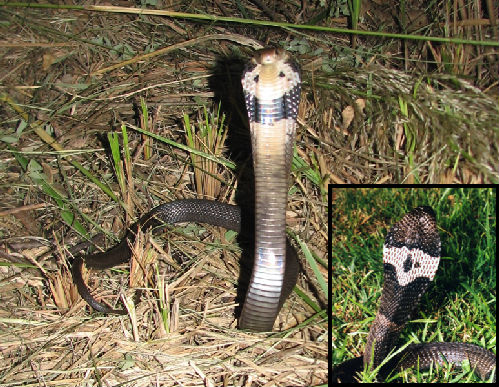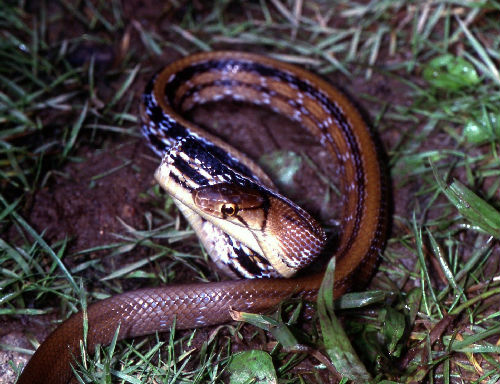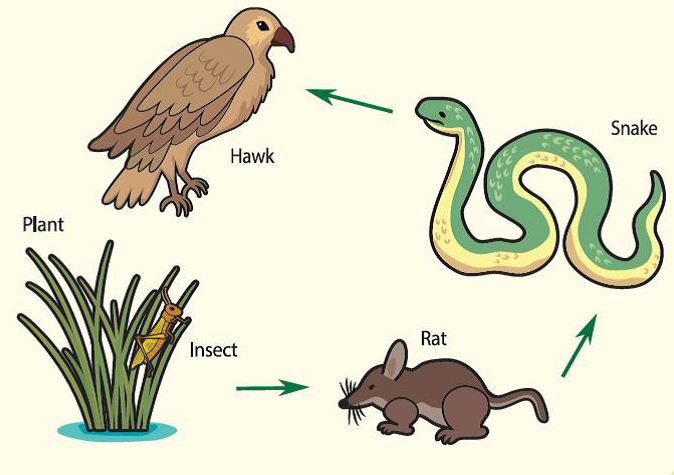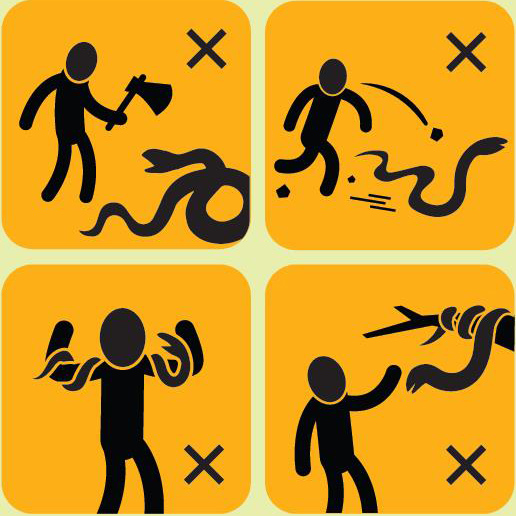What to do if you encounter a wild snake?
When you come across a wild snake, misunderstandings and improper behaviour can put both you and the snake in danger. Therefore, it is important to learn more about snakes and understand some safety measures that can be employed when encountering a snake.
Hot Summer is Time to Meet Snakes:
Snakes are more active in summer and autumn. According to records from the Wild Animal Rescue Centre (Rescue Centre), an average of 75 snakes were received each month from May to October between 2004 and 2014. A wide range of snake species were received, including both venomous and non-venomous species. During these seasons, people usually participate in more outdoor activities, such as hiking, which increases the chance of wild snakes encounters.
Top Five Snakes Received by the Rescue Centre:
Hong Kong is home to more than 50 snake species. Most of them are harmless and will only become aggressive when threatened or cornered. From our records, the following five species are the most common snakes received.
No. 1: Common Rat Snake (Ptyas mucosus)
---Image39_Fixed.jpg)
No. 2: Chinese Cobra (Naja atra)

No. 3: White-lipped Pitviper (Cryptelytrops albolabris)
_Fixed.jpg)
No. 4: Red-necked Keelback (Rhabdophis subminiatus helleri)
No. 5: Copperhead Racer (Coelognathus radiatus)

Importance of Snakes:

Snakes play an important role in the ecosystems. They make up a significant proportion of predators in food chains that balance our natural ecosystems. All lives in nature are linked in a food chain. Killing one species has a direct and indirect influence on others. Therefore killing or injuring is not a good way to treat a wild snake. Moreover, angering a snake may even lead to being bitten.
3 Good Things You Should Know about Snakes:
- Many snakes feed on animals we treat as pests such as rats and mice. They naturally control populations of these rodents which also has the effect of protecting agricultural crops in areas where farming is carried out.
- Snakes are prey for many animals including Serpent Eagles, Small Indian Civets and Mongooses. They are a key part of natural food chains.
- The Greater Green Snake and Spotted Slug-eating Snake feed on worms and slugs respectively, illustrating what a wide range of diets different snake species have.
Under normal situations, snakes are scared of human beings and will not attack intentionally. Here are some suggestions to avoid conflict with snakes.
Precautions to Avoid Snake Bite:
- Avoid areas with tall grass and brush
- Avoid putting hands or feet into crevices or holes
- Remember snakes can climb trees
- Wear shoes that can cover your toes (no slippers and sandals) and wear long pants in wild areas
- Be cautious when engaging in activities in the lakes or rivers, especially after heavy rains as snakes may be present
- Use a hiking stick to search grass or suspect areas while walking
The Wrong Way to Meet:

Please do not attempt to handle the snake by yourself, as inexperienced handling may cause unnecessary suffering to the snake and injuring to yourself.
The Right Way to Meet:
Indoor Encounter:
- Stay Calm; keep yourself, children and pets away from the snake
- Move away slowly and keep a safe distance (at least 2m) from the snake
- Call the Hong Kong Police
(If possible, someone in the vicinity should observe the snake until the Police arrive. They will remove snakes from private and public premises)
Outdoor Encounter:
- Stay Calm; keep yourself, children and pets away from the snake
- Move away slowly and keep a safe distance (at least 2m) from the snake
- Leave it alone, as it will usually try to escape to the nearest cover
What to do if you are bitten by a snake?
Dos:
✓ Move away from the snake to avoid being bitten again
✓ Stay calm and seek medical help either through hospital or by calling 999
✓ Record the time of being bitten and remember the snake’s appearance
✓ Keep the body part that has been bitten at or below the level of the heart to help maintain blood circulation at a steady level
✓ If appropriate clean the wound with water (don’t flush it with water) and soap
✓ Slow down your movement which helps to slow down the heart rate
Don’ts:
X Sucks the venom out of the injured area with the mouth
X Try to capture the snake
X Drink caffeine or alcohol, which could cause your body to absorb the venom faster
KFBG Wild Snake Rescue Project:
KFBG established a conservation project with the AFCD and the Hong Kong Police in 1999. Any stray or nuisance snakes that the Police have been alerted to are captured by a local ‘Snake Catcher’ and sent to the Rescue Centre. Native snakes are released to the countryside after a general health assessment. The project reduces the number of stray snakes in urban areas and enhances the safety of Hong Kong citizens. It also helps to relocate native snakes back to the wild and maintains the balance of the ecosystem.
When facing wild snakes, fear and violence will not help. Respect nature and enjoy the encounter experience.
If you have any enquiries, please contact us at fauna@kfbg.org.

